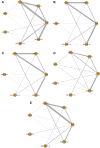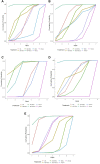Comparative Efficacy of Different Drugs for Lower Urinary Tract Symptoms due to Benign Prostatic Hyperplasia: A Bayesian Network Meta-Analysis
- PMID: 35330833
- PMCID: PMC8940212
- DOI: 10.3389/fphar.2022.763184
Comparative Efficacy of Different Drugs for Lower Urinary Tract Symptoms due to Benign Prostatic Hyperplasia: A Bayesian Network Meta-Analysis
Abstract
Background: Lower urinary tract symptoms (LUTS) caused by benign prostatic hyperplasia (BPH) are common in middle-aged and elderly men. The current drugs for treating this disease include α1-adrenoceptor antagonists (ABs), muscarinic receptor antagonists (MRAs), phosphodiesterase five inhibitors (PDE5-Is), and β3-adrenoceptor agonists (B3As). However, direct comparative studies analyzing different therapies are limited; therefore, we conducted a network meta-analysis (NMA) to evaluate the efficacy of different drug regimens for treating BPH/LUTS. Methods: The PubMed, EMbase, Web of Science, and Cochrane Library databases were searched to collect randomized controlled trials (RCTs) of different drug treatments for BPH/LUTS from January 2000 to April 2021. The NMA was performed using R 4.1 software. Results: Fifty-five RCTs were included among a total of 1639 trials. ① ABs + PDE5-Is, ABs + B3As, ABs + MRAs, ABs, and PDE5-IS were superior to the placebo in improving the total International Prostate Symptom Score (IPSS), IPSS-Voiding, and IPSS-storage. ② For increasing the maximum flow rate (Qmax), ABs + PDE5-Is, ABs + MRAs, and ABs were more effective than the placebo. ③ Regarding reducing post-void residual urine (PVR), none of the six treatment plans had significant effects. Conclusion: Combination therapy showed greater efficacy than monotherapy, and ABs + PDE5-Is was the most successful treatment for improving the overall IPSS score. ABs are a primary therapeutic measure to increase Qmax, and ABs + PDE5-I may be a more suitable choice for enhancing Qmax. The combination of MRA and AB+ MRA may lead to an increase in PVR. Systematic Review Registration: [website], identifier [registration number].
Keywords: benign prostatic hyperplasia; drug treatment; lower urinary tract symptoms; network meta-analysis; randomized controlled trial.
Copyright © 2022 Fan, Shi, Zhang, Wang and Wang.
Conflict of interest statement
The authors declare that the research was conducted in the absence of any commercial or financial relationships that could be construed as a potential conflict of interest.
Figures







Comment in
-
Benign Prostatic Hyperplasia.J Urol. 2022 Nov;208(5):1135-1137. doi: 10.1097/JU.0000000000002907. Epub 2022 Aug 11. J Urol. 2022. PMID: 35950379 No abstract available.
Similar articles
-
Alpha-blockers with or without phosphodiesterase type 5 inhibitor for treatment of lower urinary tract symptoms secondary to benign prostatic hyperplasia: a systematic review and meta-analysis.World J Urol. 2019 Jan;37(1):143-153. doi: 10.1007/s00345-018-2370-z. Epub 2018 Jun 12. World J Urol. 2019. PMID: 29948047
-
Study of phosphodiesterase 5 inhibitors and α-adrenoceptor antagonists used alone or in combination for the treatment of lower urinary tract symptoms due to benign prostatic hyperplasia.Minerva Urol Nefrol. 2020 Feb;72(1):13-21. doi: 10.23736/S0393-2249.19.03408-8. Epub 2019 Jun 21. Minerva Urol Nefrol. 2020. PMID: 31241273 Review.
-
Efficacy and safety of a hexanic extract of Serenoa repens (Permixon® ) for the treatment of lower urinary tract symptoms associated with benign prostatic hyperplasia (LUTS/BPH): systematic review and meta-analysis of randomised controlled trials and observational studies.BJU Int. 2018 Dec;122(6):1049-1065. doi: 10.1111/bju.14362. Epub 2018 Jun 6. BJU Int. 2018. PMID: 29694707
-
Efficacy and Safety of Hexanic Lipidosterolic Extract of Serenoa repens (Permixon) in the Treatment of Lower Urinary Tract Symptoms Due to Benign Prostatic Hyperplasia: Systematic Review and Meta-analysis of Randomized Controlled Trials.Eur Urol Focus. 2016 Dec;2(5):553-561. doi: 10.1016/j.euf.2016.04.002. Epub 2016 Apr 23. Eur Urol Focus. 2016. PMID: 28723522 Review.
-
Phosphodiesterase inhibitors for lower urinary tract symptoms consistent with benign prostatic hyperplasia.BJU Int. 2019 Jul;124(1):27-34. doi: 10.1111/bju.14689. Epub 2019 Mar 11. BJU Int. 2019. PMID: 30681264
Cited by
-
Diacerein provokes apoptosis, improves redox balance, and downregulates PCNA and TNF-α in a rat model of testosterone-induced benign prostatic hyperplasia: A new non-invasive approach.PLoS One. 2023 Nov 9;18(11):e0293682. doi: 10.1371/journal.pone.0293682. eCollection 2023. PLoS One. 2023. PMID: 37943844 Free PMC article.
-
Technological innovation of HoLEP: a multicenter, randomized, controlled study for the treatment of lower urinary tract symptoms secondary to benign prostatic hyperplasia.World J Urol. 2025 Jan 10;43(1):64. doi: 10.1007/s00345-024-05438-8. World J Urol. 2025. PMID: 39789390 Clinical Trial.
-
A correlation study between prostate necrosis rate calculated by 3D Slicer software and clinical efficacy of prostatic artery embolization, along with an analysis of predictors of clinical success after prostatic artery embolization.Abdom Radiol (NY). 2024 Mar;49(3):927-938. doi: 10.1007/s00261-023-04131-5. Epub 2023 Dec 29. Abdom Radiol (NY). 2024. PMID: 38158423
-
Associations between the risk of LUTS/BPH and the number and class of chronic diseases among middle-aged and elder men.Sci Rep. 2025 Apr 29;15(1):14965. doi: 10.1038/s41598-025-00057-8. Sci Rep. 2025. PMID: 40301381 Free PMC article.
-
Comparative efficacy and safety of silodosin and tadalafil combination or monotherapy for treating lower urinary tract symptoms due to benign prostatic obstruction: A systematic review and meta-analysis.Cent European J Urol. 2025;78(2):165-176. doi: 10.5173/ceju.2024.0219. Epub 2025 May 7. Cent European J Urol. 2025. PMID: 40873873 Free PMC article. Review.
References
Publication types
LinkOut - more resources
Full Text Sources
Research Materials
Miscellaneous

